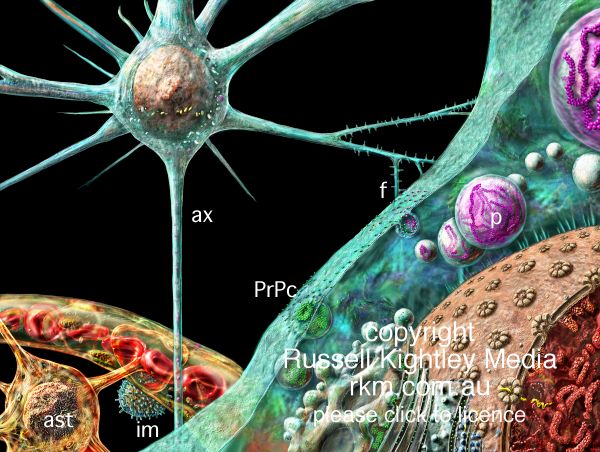By Megan Brooks
Medscape Medical News
May 26, 2010 — In a transgenic mouse model of Alzheimer's disease (AD), cellular prion protein (PrP) is an essential mediator of memory impairment, researchers report. The finding, they say, could offer a novel target for the development of new drugs to treat AD.
Their report was published in the May 5 issue of The Journal of Neuroscience.
"The major finding of this study is that memory deficits in AD transgenic mice require the presence of cellular PrP," the study authors, from Yale University in New Haven, Connecticut, report in the article. "In addition to rescuing impairments in spatial memory, deletion of [PrP] expression improved survival and prevented loss of serotonin axons and synaptic markers."
When cellular PrP is absent, transgenic AD mice show no detectable impairment in learning and memory, senior study author Stephen M. Strittmatter, MD, PhD, director of the Cellular Neuroscience, Neurodegeneration, and Repair Program at Yale, noted in an email toMedscape Neurology. "They still make amyloid plaque, but the amyloid-β does not harm brain function. This shows that prion protein is key downstream of β-amyloid and the plaque and symptoms can be dissociated," he explained.
"Blocking amyloid-β binding to prion protein is a good drug target mechanism likely to be very effective with few side effects," Dr. Strittmatter predicted.
According to a Yale University–issued statement, New Haven–based biotechnology company Axerion Therapeutics Inc has licensed the rights to further the Yale research and plans to investigate potential clinical applications.
Dr. Strittmatter is a founding member of Axerion. The current research was funded by the National Institutes of Health, Alzheimer's Association, and the Falk Medical Research Trust.
Amyloid: Symptom or Adverse Effect?
Whether amyloid-β plaques cause dementia, memory loss, and other classic symptoms of AD or are merely an adverse effect of the disease process remains largely a subject of debate.
In earlier research, Dr. Strittmatter and colleagues found that amyloid-β oligomers bind to cellular PrP, leading to neuronal damage, even in the absence of large amyloid plaques. In their latest research, they show that AD transgenic mice lacking cellular PrP accumulate amyloid-β but show normal survival and cognitive function.
"The most important issue at this point is whether these data are robustly reproducible," Samuel Gandy MD, PhD, professor of neurology and psychiatry and associate director of the Alzheimer's Disease Research Center at the Mount Sinai School of Medicine, New York City, who was not involved in the research, told Medscape Neurology.
"I remain cautious," he added, "because a number of putative amyloid receptors and pathways have come and gone because they were not robustly reproducible."
"However, it is well established that prion plaques are surrounded by a halo of amyloid-β deposits, so there is some precedent for the 2 proteins interacting," Dr. Gandy noted. "This piece of historical data and context makes the new data all the more titillating, so I will definitely follow the story with interest and see how it plays out."
If the findings are reproduced, "then PrP would become an outstanding target for new drugs.?This model would predict that PrP vaccines would protect against amyloid toxicity...and PrP binding drugs would do the same," Dr. Gandy said.
"Axerion is excited to begin translating this science into a therapeutic approach that will block the binding of harmful β-amyloid oligomers to these prion proteins and thereby reduce the devastating effects of Alzheimer's disease," said Sylvia McBrinn, president and chief executive officer of the company.
The research was funded by the National Institutes of Health, Alzheimer's Association, and the Falk Medical Research Trust. Dr. Strittmatter is a founding member of Axerion. Dr. Gandy has disclosed no relevant financial relationships.
J Neurosci. 2010;30:6367-6374. Published online May 5, 2010.
作者:Megan Brooks
出處:WebMD醫學新聞
【24drs.com】May 26, 2010 — 研究者報告指出,在轉基因老鼠模式的阿茲海默氏症(Alzheimer's disease,AD)中,細胞中的prion蛋白質(PrP)是記憶缺損的重要調節因子,他們表示,這個發現可以為發展治療AD的新藥提供一個新目標。
他們的報告發表於5月5日的神經科學期刊(The Journal of Neuroscience)。
來自耶魯大學的研究作者在文中指出,本研究的主要發現是,AD轉基因老鼠的記憶缺損與出現細胞內PrP有關。刪除PrP除了可以拯救空間記憶的缺損,還可以改善存活與避免失去血清素軸突和突觸標記。
資深作者、耶魯「細胞神經科學、神經退化與修補計畫(Cellular Neuroscience, Neurodegeneration, and Repair Program)」主任Stephen M. Strittmatter博士以電子郵件向Medscape Neurology指出,當缺乏細胞內PrP時,轉基因AD老鼠在學習與記憶上並無可察覺的缺損。牠們依舊製造澱粉樣斑塊,但是,乙型澱粉樣蛋白並不會傷害腦部功能;這顯示,prion蛋白質是乙型澱粉樣蛋白的關鍵下游,斑塊和症狀之間可以被分開。
Strittmatter博士預期,阻斷乙型澱粉樣蛋白結合到prion蛋白質是一個不錯的藥物標靶機轉,可能會相當有效且很少副作用。
根據耶魯大學發表的聲明,位於紐哈芬的生物科技公司Axerion Therapeutics Inc已經授權給耶魯進行後續研究,並且計畫探討可能的臨床應用。
Strittmatter博士是Axerion公司的發起人之一,目前的研究接受國家健康研究中心、阿茲海默氏症協會以及Falk Medical Research Trust等資助。
【澱粉樣蛋白:症狀或副作用?】
乙型澱粉樣蛋白是否引起失智、記憶喪失與其他AD典型症狀,或者只是疾病過程中的一個副作用,仍然是個相當大的爭論主題。
在稍早的研究中,Strittmatter博士等人發現,乙型澱粉樣蛋白寡聚體(amyloid-β oligomers)結合到細胞的PrP,會導致神經元損傷,即使沒有大澱粉樣蛋白斑塊時也是如此。在他們的最新研究中指出,缺乏細胞PrP的AD轉基因老鼠,累積乙型澱粉樣蛋白,但是有正常存活與認知功能。
紐約市西奈山醫學院阿茲海默氏症研究中心副主任、神經與精神科教授、未參與此研究的Samuel Gandy博士向Medscape Neurology表示,目前,最重要的議題是,這些資料是否可以明確地重現。
他指出,我依舊相當謹慎,有些澱粉樣蛋白受體與路徑理論被提出後,因為未能明確地重現而又消失了。
Gandy博士指出,不過,已經相當確定,prion斑塊週遭有一圈乙型澱粉樣蛋白沉積,所以,先前即有這兩種蛋白質有交互作用的一些先例,這些歷史資料和內文都讓這個新資料更加令人高興,所以,我將明確地追循這個說法並看它如何作用。
Gandy博士表示,如果研究發現被重現,那麼,PrP將成為新藥的重要標靶,將可預期有PrP疫苗用來預防澱粉樣蛋白毒性,PrP結合藥物也是如此。
該公司總裁暨執行長Sylvia McBrinn表示,Axerion公司很高興將這項科學轉為治療方式,藉由阻斷有害的乙型澱粉樣蛋白寡聚體結合到這些prion蛋白質,減少阿茲海默氏症的破壞效果。
該研究接受國家健康研究中心、阿茲海默氏症協會以及Falk Medical Research Trust等資助。Strittmatter 博士是Axerion公司的發起人之一,Gandy博士宣告沒有相關財務關係。
J Neurosci. 2010;30:6367-6374. 現上發表於2010年5月5日。
prion你可能會對他有點印象,讓我幫你複習一下吧:





 留言列表
留言列表
 線上藥物查詢
線上藥物查詢 